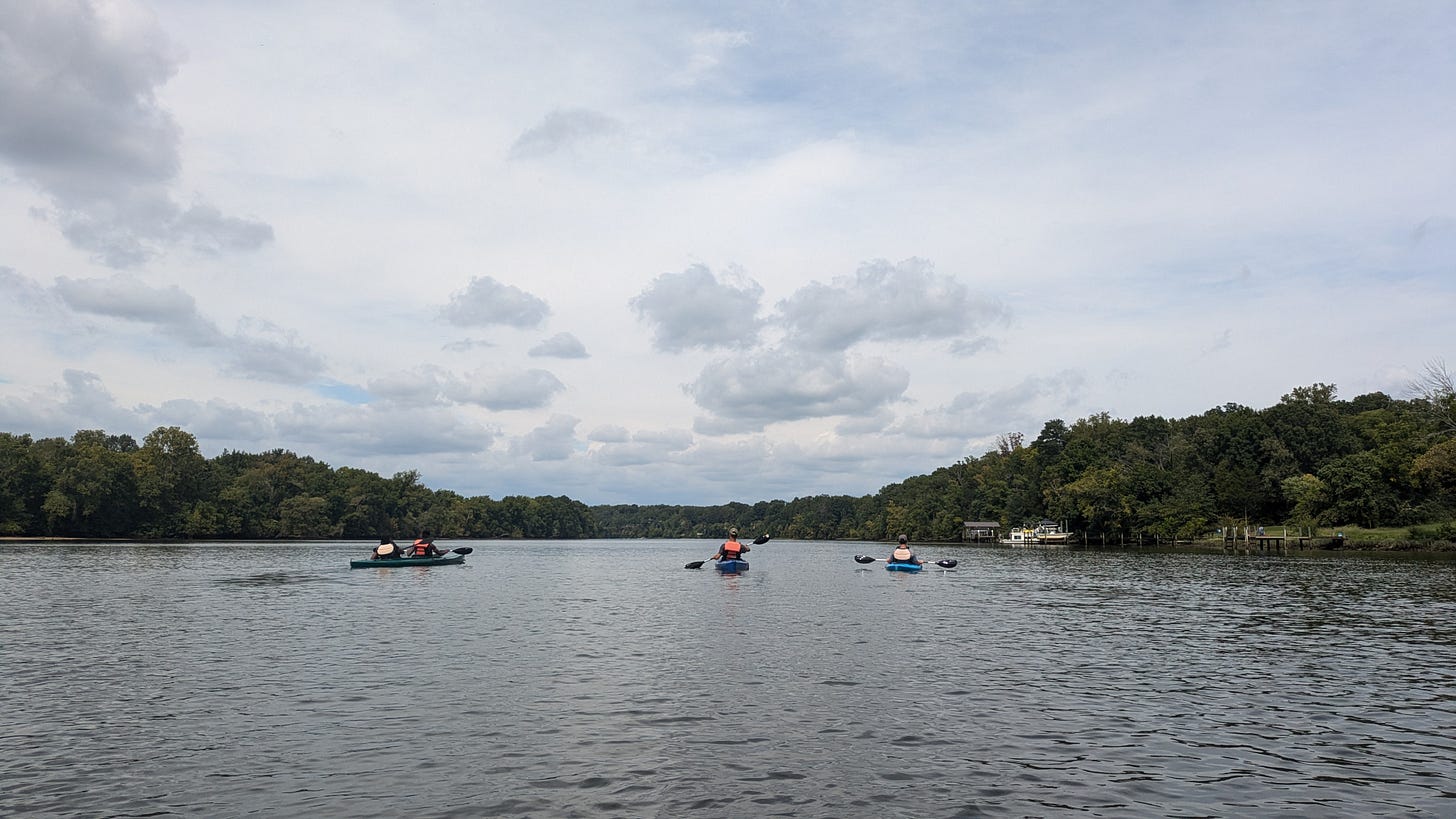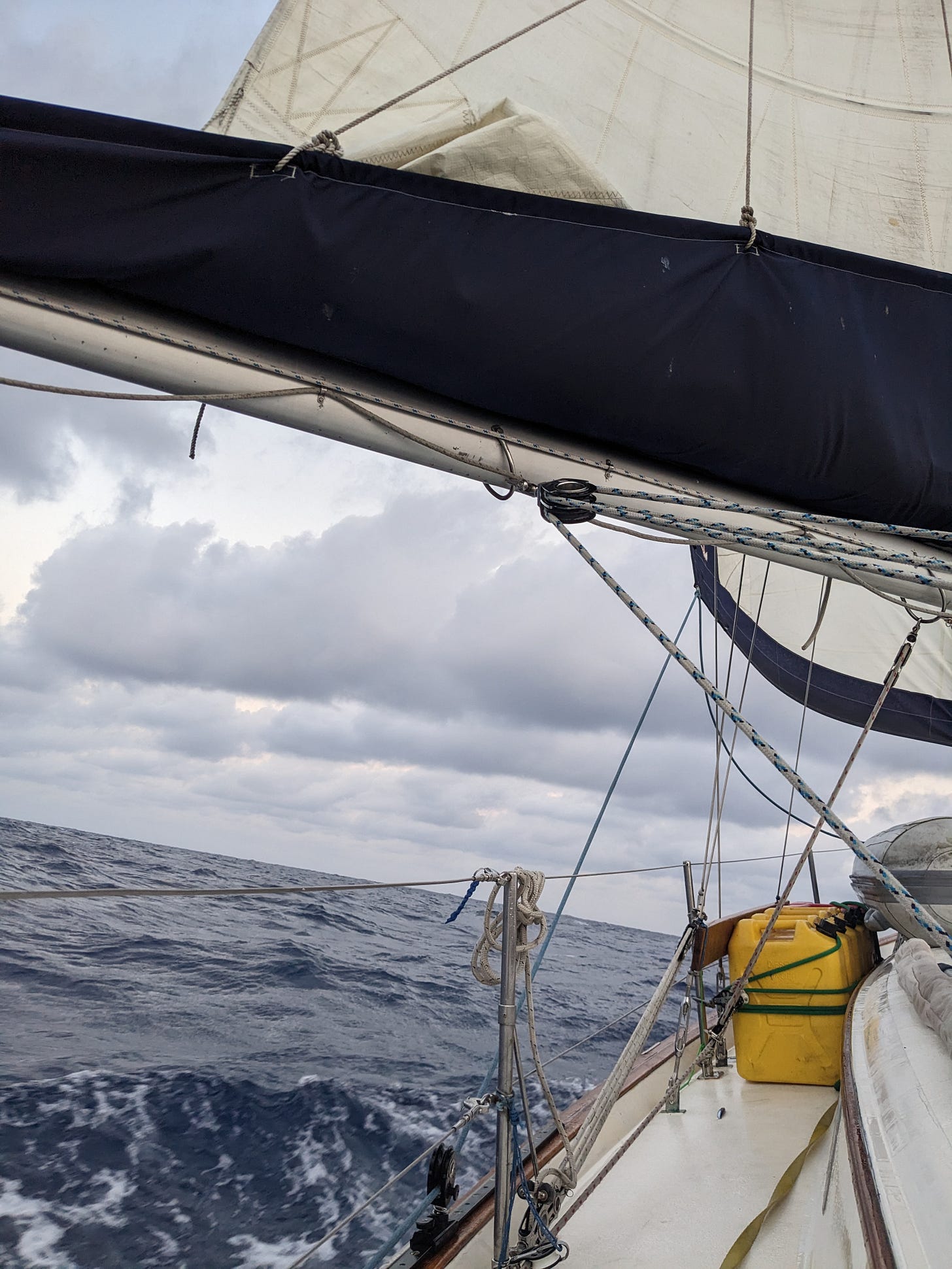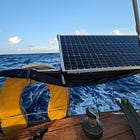Cold Front
Hello from the kitchen table
September 8, 2024, 08:48, high tide, waxing crescent, Late Summer
High 75ºF/ Low 51ºF, sunny, pressure 1018 mb, 3.68 feet
A cold front moved in yesterday, reminding us of the weather on our 1000-mile crossing from Cartagena, Colombia to Isla Mujeres, Mexico in March 2022.
Yesterday I was kayaking on the James River for several hours guiding Sturgeon Tours. The Atlantic sturgeon returns yearly to spawn, as it has for tens of millions of years. Their presence in the James was nearly lost, but rebounded due to the Clean Water Act in 1972 and fishing bans in 1974. They average 9’ in length and make miraculous leaps from the river. We spotted a few on our trips up and downstream. The weather in the first group was sunny with a breeze coming from the East. Around noon, the breeze clocked around and grey clouds moved in, reminding me of some unsettling weather we experienced a year and a half ago on open seas. The tour concluded, a sweet time with two college friends reuniting and a nephew surprising his aunt for her 56th birthday. All were first-time paddlers who were taken by the peace of being on calm waters with nowhere else to be. They helped me load the kayaks back on the pickup truck, I snapped some photos on their phones to commemorate the day, and rolled back to the paddlesports shop. The wind increased and veered toward the first chilly daytime temps we have experienced here since Spring. Almost as if blown in by the wind, a group of SUVs arrived to return their kayak returns, creating a flurry of re-stowing gear and washing lifejackets. I heard the group’s tales of paddling the nearby Pamunkey River and drove home to find Scott and our cat Cypress enjoying the show of weather in the backyard. We had mirrored thoughts about that cold front in the Caribbean and went down memory lane.
This morning I woke early to Scott sifting through drawers for warmer layers to top his usual cycling kit. Scott and Cypress have a steadfast routine of sitting on the porch over coffee in the morning, so I next heard the meows of a disappointed kitty as he headed out the door. I grabbed the blanket I knit throughout 2018, The Absent Hand by Suzannah Lessard, and Cypress’ harness. We enjoyed a chapter and the scurrying of squirrels as they stash walnuts this time of year. The chill brought us to the couch for another chapter, and then hunger brought me to the stove for the remainder of a pack of bacon and steel-cut oats, a decidedly Gremel breakfast.
The first 7,000 miles of our route from San Francisco to the Chesapeake Bay was a straightforward southeasterly path along the Pacific coastline to Panama. The weather largely dictated where we stopped along the way, as well as tips from fellow sailors and guidebooks. Our Caribbean crossing however held question marks from the start. We could hug the Central American coastline, risking reefs and leeward shores near Nicaragua, take the famed Windward Passage upwind through the gap between Cuba and Haiti, or split the difference and make one long trek up to the Yucatan Peninsula. We consulted weather router Chris Parker and the salty sailors at the marina bar in Cartagena, Colombia during a four-month wait for the tradewinds to lessen. We nearly lost our ship and ourselves on the crossing to Colombia, and the stint in the Walled City was both a respite and a worry as we stared down our longest passage yet across notoriously choppy seas. Two sailors left impatiently before the turning of the season and lessening of the tradewinds, one was confirmed dead and the other made it back to port and sold his vessel. We called our friend John in for reinforcements and left with him a few weeks later.
While offshore, we keep in touch via our Garmin InReach satellite phone. We could contact Chris Parker’s team at the Marine Weather Center to request personalized updates and routing recommendations, as well as Fast Seas which provides something similar through software. We filed float plans (documents including our expected route and ETA) and provided daily updates to a group that included a family member for each of us, plus two sailor friends, Dave and Carla. Dave was our race skipper for many years and weighed in on the weather, and Carla was my race skipper in Brooklyn. She is the all-around badass who would run point if we ran into a rescue situation. This is all much more connectivity than sailors have enjoyed throughout the centuries, but fairly sparse for the age of smartphones.
We left Cartagena with a good weather window and the certain uncertainty of the weather beyond the predictable 3-day forecast. We planned to sail 1000 miles to Isla Mujeres (woman island), Mexico over 8-10 days, with a possible detour to small islands off Nicaragua or the Cayman Islands. Around six days in, we received reports of an incoming cold front that might cause us to divert to the Caymans. We hoped to avoid this, wanting to get John to his flight, make more distance as a group, and avoid the notoriously expensive area. We sat in uncertainty for forty-eight hours, a long time on open seas.
Our weather router reported 25-30 winds on the nose and choppy seas created by wind opposing the Gulf Stream. He recommended we stay the course to Mexico, and as a crew, we weighed our options for hours. The passage had been brochure sailing up that point, fair winds and following seas. We had eaten two steak dinners and felt well-rested with our watch schedule of four hours on and eight hours off. After conferring with Carla and Dave for their opinions too, we stayed the course.
The first sign of the new weather was a large white shore bird, caught at sea, and catching a ride with us. Then the clouds came ominously like a wall, making it a clear why these are called “fronts”. For our weather router, it was standard practice to capitalize this word in every update, which became a bit of an inside joke for us to make light of the impending FRONT.
It’s difficult to record the tough times onboard as they’re happening, but this blurry photo of the shorebird shares how it’s imprinted in my memory. I had the toughest watch of the new weather, heeled over, pelting rain, and the Caymans in the rearview. Our additional crew member meant that we each had the promise of eight hours in our bunks at the end of each shift, which made holding fast in the conditions almost easy. We had reefed sails in anticipation and had about 300 miles to go. Our sailboat Azimuth flew along at top speeds and we dropped into easy meals and minimal activity besides trimming sails, checking the horizon, and monitoring for changes in weather.
This time of year feels a bit like an impending cold front. Change is in the air and certain uncertainty looms as we shift toward fall. My season on the river is closing and return to deskwork is imminent. I’m grateful for my time on inland waters and the space it provided to process my bluewater experiences. Our time at sea honed our ability to ride the waves of change, and river guiding cracked open my ability to share that skill. I hope to do more of the same here in my writings, stay tuned.
More info:
A friend and fellow river guide made a mini-doc about the sturgeon with some buddies last year. I love how the Headwaters Down guys tell stories that inspire others to protect landscapes and get out there.
I shared snippets from my notes app about the crossing from Cartagena right after it. Those live here:
For a better view of the bird before the weather turned, see this video:







